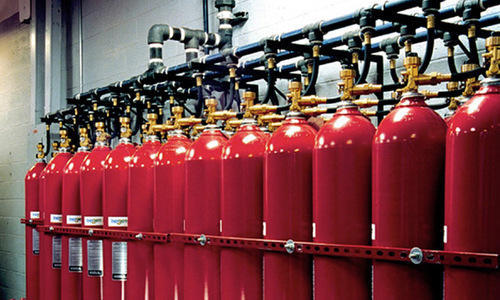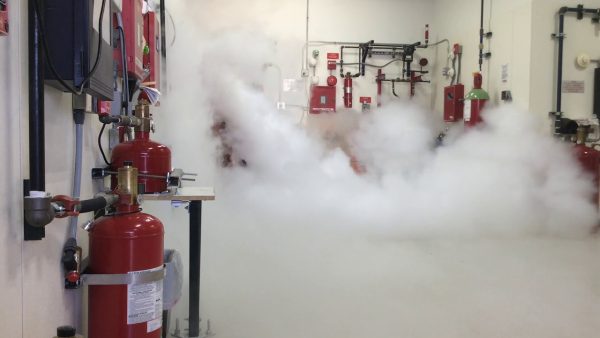

CO2 Suppression System
To put out a fire, a CO2 fire suppression system eliminates oxygen. When the suppression system detects smoke or fire, it releases the CO2 agent into the protected space.
To put out a fire, several different types of agents are used in a suppression system. Clean agent or inert gas suppression systems are commonly found in server rooms and other environments where personnel work. CO2 fire suppression systems are typically found in environments with little or no personnel. CO2 fire suppression systems can be found in engine rooms, generator rooms, power stations, flammable liquid storage rooms, and around large industrial machines.
While CO2 fire suppression systems are extremely effective at putting out fires, the CO2 agent is also hazardous to one’s health when compared to other agents. As a result, CO2 fire suppression systems are most commonly found in unoccupied buildings.
Fire Suppression System
Fire suppression systems are designed to suppress or extinguish a fire in sensitive environments where water from a fire sprinkler is not a desired extinguishing agent. There are a few different types of agents that are used in a suppression system to suppress the fire. In server rooms and environments where you have personnel working in the area, you will usually find clean agent or inert gas suppression systems. In environments where there are few personnel or none at all, you will typically find CO2 fire suppression systems. The areas that you’ll find CO2 fire suppression systems include engine rooms, generator rooms, power stations, flammable liquid storage rooms, and around large industrial machines.
What is a CO2 Fire Suppression System?
While CO2 fire suppression systems are highly effective at suppressing fires, the CO2 agent also poses a health risk when compared to the other agents. For this reason, you’ll find CO2 fire suppression systems most often in non-occupied environments. CO2 fire suppression system is extremely versatile and effective on a wide range of flammable and combustible materials that been approved for Class A, B and C hazards. CO2 is a colourless, odourless, electrically non-conductive gas that is highly efficient as a fire suppression agent and leaves no residue behind. CO2 fire protection systems use intelligent, reliable and fast-acting control panels to quickly sense a fire before it can cause damage to property. CO2 gas has a high rate of expansion, which allows a CO2 fire protection system to work fast.

CO2 fire protection systems are available for use in total flooding or local fire protection applications and are ideal for protecting high value assets where large quantities of agent is required.
These include dip tanks, rolling mills, data processing centers, vaults/tape storage and marine machinery spaces – making it an effective fire protection system for a wide variety of hazards.
CO2 Suppression System Calculator
Disclaimer: This calculator is only to be used as guidance and does not provide the definitive answer.
How does a CO2 Fire Suppression System put out a Fire?
A fire needs oxygen, fuel, and heat to continue to burn. By eliminating one of these three elements, a fire can be suppressed or extinguished. While some suppression agents reduce the heat of the fire, a CO2 fire suppression system eliminates the oxygen to suppress the fire. When the suppression system detects smoke or fire, it then releases the CO2 agent into the space it is protecting. The CO2 level in the space quickly increases as the oxygen level quickly drops causing the fire to be suppressed or extinguished.
CO2 provides a heavy blanket of gas that reduces the oxygen level to a point where combustion cannot occur. Since carbon dioxide is a gas, there is no clean-up associated with a CO2 fire suppression system discharge. This means any sensitive equipment that is in the protected space is not damaged by the CO2, which reduces downtime and costs.
Once the CO2 has dispersed to safe levels from the protected space, personnel can access any damage from the fire or smoke and quickly get back to work with no clean up needed. The system will extinguish gas—rather than water, foam, or dry chemicals—that can efficiently and quickly stop a fire without damaging any sensitive electronic equipment or your assets.

Is a CO2 Fire Suppression System Dangerous?
At 7.5% concentration, CO2 can cause asphyxiation to humans. Most CO2 fire suppression systems are designed to have 34% CO2 concentrations for a total flood of the protected space. Due to the obvious dangers of CO2, the CO2 fire suppression systems are required to have certain life safety devices to protect personnel around or near the protected spaces.
One of the life safety devices is a pneumatic siren that warns people around the area that the CO2 will be discharging from the suppression system. It is important to properly train all personnel on the dangers of the CO2 fire suppression system and how to evacuate safely if the system is preparing to dump the CO2 to suppress the fire.
The good news is AITO has capable technician that can possess the required abilities and information.


